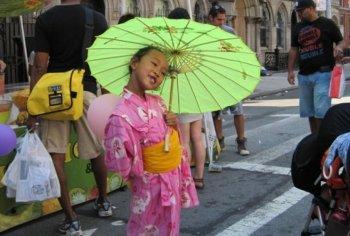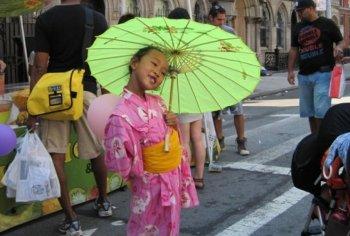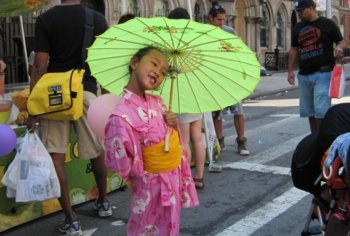NEW YORK—On a sweltering afternoon in the East Village, sizzling grills could be heard long before food stalls came in sight. Wafts of smoke filled the air and raised the temperature a few degrees. But these sounds and smells were not from ordinary sausages and peppers on the grill. Instead, they emanated the JapanTown Festival, where an eclectic platter of Japanese street food, provided by East Village restaurants and shops, were already local favorites.
Take Otafuku, for example, a beloved hole-in-the-wall joint whose famous takoyaki and okonomiyaki drew long lines of customers. The takoyaki, which are ball-shaped fritters filled with octopus, scallions, and ginger, were in such high demand that the vendors informed us we would have to wait 30 minutes for our orders to be ready.
The okonomiyaki are fried pancakes made with a batter of flour, cabbage, and ginger, and topped with a sweet, tangy sauce (named after the pancakes), Japanese mayo, and thin katsuobushi flakes, or dried bonito fish shavings. When the pancakes are just made, the rising steam causes the bonito flake toppings to dance, and at first glance, appears as if it’s moving. But have no fear; the quirky dish is well-cooked.
Another crowd-pleaser was the grilled Tonton pork, provided by a small, but popular restaurant in West Village, Hakata Tonton. Betty Tan, the public relations director for the festival, explained that Hakata Tonton specializes in serving “Japanese soul food,” using cooking methods from the island of Kyushu, located in the southern region of the country. The restaurant features a wide variety of pork dishes, from their signature pigs’ feet, to a hot pot with Berkshire pork.
The Right Place for Authentic Food
Take Otafuku, for example, a beloved hole-in-the-wall joint whose famous takoyaki and okonomiyaki drew long lines of customers. The takoyaki, which are ball-shaped fritters filled with octopus, scallions, and ginger, were in such high demand that the vendors informed us we would have to wait 30 minutes for our orders to be ready.
The okonomiyaki are fried pancakes made with a batter of flour, cabbage, and ginger, and topped with a sweet, tangy sauce (named after the pancakes), Japanese mayo, and thin katsuobushi flakes, or dried bonito fish shavings. When the pancakes are just made, the rising steam causes the bonito flake toppings to dance, and at first glance, appears as if it’s moving. But have no fear; the quirky dish is well-cooked.
Another crowd-pleaser was the grilled Tonton pork, provided by a small, but popular restaurant in West Village, Hakata Tonton. Betty Tan, the public relations director for the festival, explained that Hakata Tonton specializes in serving “Japanese soul food,” using cooking methods from the island of Kyushu, located in the southern region of the country. The restaurant features a wide variety of pork dishes, from their signature pigs’ feet, to a hot pot with Berkshire pork.








